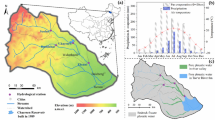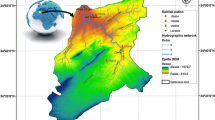Abstract
The groundwater table in the piedmont plain was only about 1–2 m in depth in the 1950s and 1960s, but it lowered dramatically afterwards to about 25–27 m in depth (currently 21–23 m above sea level) due to overpumping of groundwater and drought in the region. This change has adversely affected the sustainable development and food supply of this important agricultural area. The groundwater table at Luancheng Experimental Station of the Chinese Academy of Sciences, located in the piedmont, dropped from 39.36 m in 1975 to 21.47 m above sea level in 1999, at an average rate of 0.72 m/year. Water balance components, such as daily rainfall, pan-evaporation, and evapotranspiration (by lysimeter after 1995) have been recorded since the 1970s, and they were used as variants to simulate monthly water table change based on a physically based statistical model. Groundwater samples were collected during the period 1998–2001, and tritium was measured in the laboratory to trace the groundwater flow from the Taihang Mountains to the piedmont. A reasonable exploitation rate of 150 mm/year was obtained from the model by assuming the annual water table is constant. The recharge and groundwater flow from the Taihang Mountains plays an important role in the water balance of the piedmont area, and it was estimated to be about 112.5 mm/year by using the variation of tritium with the depth, which followed a good exponential function. The simple water balance calculation indicated that the water table could recede at a rate of 0.8 m/year, which is close to the actual situation.







Similar content being viewed by others
References
Brown LR, Halweil B (1998) China's water shortage could shake world food security. World Watch, July/August:10–18
Chen ZY, Zhang GH, Xu JM (1998) Paleoclimate record deduced from groundwater and climate change implications of groundwater resources in North China (in Chinese). ACTA Geoscientia Sinica 4:338–345
Cheng RN (1988) Tracing water interaction by using natural isotopes. In: Liu CM, Ren HZ (eds) Air, surface, soil and ground water interactions—experiment and calculation analysis (in Chinese). Science Press, Beijing, pp 33–50
Clark CO (1945) Storage and the unit hydrograph. Trans Am Soc Civil Eng 110:1419–1446
Eshleman KN, Pollard JS, O'Brien AK (1994) Interactions between groundwater and surface water in a Virginia coastal plain watershed 1. Hydrological flowpaths. Hydrol Processes 8:389–410
Hu CS, Yin YF (1998) Modeling dynamics of groundwater in Luancheng County (in Chinese). Progr Geogr 17 (Suppl):26–31
James ER, Manga M, Rose TP, Hudson GB (2000) The use of temperature and the isotopes of O, H, C, and noble gases to determine the pattern and the spatial extent of groundwater flow. J Hydrol 237:100–112
Kitaoka K (1988) A model of quality distribution in groundwater with reference to natural tritium concentration. Jf Groundwater Hydrol 30:77–93
Li SZ, Cui ZL, Wang HY (1998) On comparison of several methods to estimate the reasonable exploitation rate of groundwater resource (in Chinese). Hydrol Water Resour 19:5-9
Liang GC (1986) Linear models for multiple inflows- single outflow routing in real time. PhD Thesis, Department of Engineering Hydrology, University College Galway, Ireland
Liu CM, Wang HX (1999) The interface processes of water movement in the soil-crop-atmosphere system and water-saving regulation (in Chinese). Science Press, Beijing, pp 86–87, 92–97, 14–18
Liu CM, Yu JJ, Kendy Eloise (2001) Groundwater exploitation and its impact on the environment in the North China Plain. Water Int 26:265–272
Liu CM, Zhang XY, Zhang YQ (2002) Determination of daily evaporation and evapotranspiration of winter wheat and maize by large-scale weighing lysimeter and micro-lysimeter. Agricult For Meteorol 111:109–120
Mihelcic JR (1999) Fundamentals of environmental engineering. Wiley, New York, pp 196–198
Nash JE, Foley JJ (1982) Linear models of rainfall- runoff systems. In: Rainfall–Runoff Relationship, Proceedings of the International Symposium on Rainfall Runoff Modeling, Water Resources Publications
O`Brien AK, Eshleman KN, Pollard JS (1994) Interactions between groundwater and surface water in a Virginia coastal plain watershed 2. Acid-base chemistry. Hydrol Processes 8:411–427
Stuyfzand PJ (1999) Patterns in groundwater chemistry resulting from groundwater flow. Hydrogeol J 7:15–27
Toth J (1999) Groundwater as a geologic agent: An overview of the causes, processes and manifestations. Hydrogeol J 7:1-14
Vogel JC (1967) Investigation of groundwater flow with radiocarbon. In: Isotopes in hydrology. IAEA. Vienna, pp 355–369
Vogel JC (1970) Carbon-14 dating of groundwater. In: Isotope in hydrology. IAEA. Vienna, pp 225–239
Wang ZY, Li SZ, Xin XM (1998) Application of statistical analysis in the calculation of groundwater resource in Yuncheng City of Shanxi Province. (in Chinese) Hydrol Water Resour 19:8–12
Wu C, Xu QH, Zhang XQ, Ma YH (1996) Paleochannels on the North China Plain: types and distributions. Geomorphology 18:5–14
Xu QH, Wu C, Yang XL, Zhang NJ (1996) Paleochannels on the North China Plain: relationships between their development and tectonics. Geomorphology 18:27–35
Yang YS, Lin XY, Elliot T, Kalin RM (2001) A natural-gradient field tracer test for evaluation of pollutant-transport parameters in a porous-medium aquifer. Hydrogeol J 9:313–320
Zhang GH, Chen ZY, Fei YH (2000) Relationship between the formation of groundwater and the evolution of regional hydrologic cycle in the North China Plain (in Chinese). Adv Water Sci 4:415–420
Zhou L, Liu CF, Jiang S, Gao S (2001) A study of 36Cl age in quaternary groundwater of Hebei Plain, China. Sci China (Series E) 44 (Suppl):11–15
Zhou YH, Li BQ, Zhao JY (1991) On the development of a large-scale weighing lysimeter. In: Annual Report of Yucheng Experimental Station, 1988–2000 (in Chinese). Meteorological Press, Beijing, pp 55–62
Zhu YH (1992) Comprehensive hydrogeologic evaluation of the Huang-Huai-Hai Plain (in Chinese). Geological Publishing House of China, Beijing
Acknowledgments
The authors gratefully acknowledge aid grants for scientific research from the Ministry of Education, Culture, Sports, Science and Technology of Japan, (B)(2) 12480146, 2000 and (B)(2) 13480152, 2001 and funds from the Ministry of Sciences and Technology of China, G19990436-01 (National 973 project). We are also grateful to those who helped to collect water samples during the field survey from both Shijiazhuang Institute of Agricultural Modernization, CAS and from various Japanese universities. Thanks are expressed to anonymous referees for improvements to an earlier draft of this paper.
Author information
Authors and Affiliations
Corresponding author
Rights and permissions
About this article
Cite this article
Chen, J.Y., Tang, C.Y., Shen, Y.J. et al. Use of water balance calculation and tritium to examine the dropdown of groundwater table in the piedmont of the North China Plain (NCP). Env Geol 44, 564–571 (2003). https://doi.org/10.1007/s00254-003-0792-3
Received:
Accepted:
Published:
Issue Date:
DOI: https://doi.org/10.1007/s00254-003-0792-3




